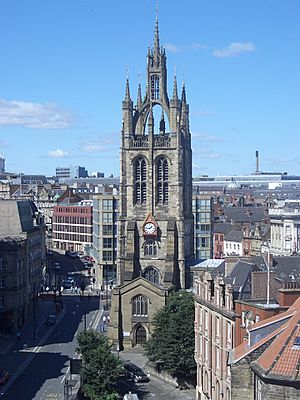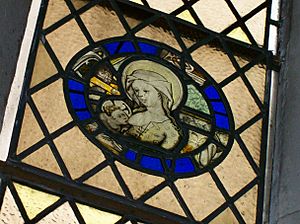Newcastle Cathedral facts for kids
Quick facts for kids Newcastle Cathedral |
|
|---|---|
| Cathedral Church of St Nicholas | |
 |
|
| Lua error in Module:Location_map at line 420: attempt to index field 'wikibase' (a nil value). | |
| Location | Newcastle upon Tyne, Tyne and Wear |
| Country | England |
| Denomination | Church of England |
| Previous denomination | Catholic |
| Tradition | High Church |
| Website | newcastlecathedral.org.uk |
| Architecture | |
| Functional status | Active |
| Heritage designation | Grade I |
| Style | English Gothic |
| Years built | 1091 – c. 1500 |
| Specifications | |
| Capacity | 1,000 |
| Number of towers | one |
| Spire height | 194 feet (59 metres) |
| Administration | |
| Diocese | Newcastle (since 1882) |
| Province | York |
Newcastle Cathedral, also known as the Cathedral Church of St Nicholas, is an important Church of England building in Newcastle upon Tyne, England. It is the main church for the Bishop of Newcastle. It also serves as the "mother church" for the entire Diocese of Newcastle.
This diocese is the most northern part of the Anglican Church in England. It stretches from the River Tyne all the way up to Berwick-upon-Tweed. It also goes west to Alston in Cumbria. The cathedral is a very old and special building, listed as Grade I.
The church was first built in 1091, around the same time as the nearby castle. A fire destroyed the original Norman church in 1216. The building you see today was finished in 1350. It mostly shows the Perpendicular style of the 14th century. Its tower is famous for its unique 15th-century lantern spire. The building was greatly repaired in 1777. It became a cathedral in 1882, taking on the name Cathedral Church of St Nicholas.
Contents
History of Newcastle Cathedral
Why is it called St Nicholas?
The cathedral is named after St Nicholas. He is known as the patron saint of sailors and boats. This name might be because the cathedral stands high up above the River Tyne. It was first a local church, built in 1091. It was built near where Hadrian's Wall passed through Newcastle. The exact path of the wall in the city centre is not known today.
From Parish Church to Cathedral
Close to the south of the cathedral is Newcastle Castle. This castle gave the city its name. It was built on the site of an old Roman fort called Pons Aelius. The first Norman church was destroyed by fire in 1216. The current building was finished in 1350.
In the mid-1800s, Newcastle's population grew a lot. This led to more than 20 new churches being built. As Newcastle kept growing, it needed its own church area, or diocese. So, in 1882, the Diocese of Newcastle was created. St Nicholas's then became its main cathedral.
The Famous Lantern Spire
The cathedral is well-known for its unusual lantern spire. This spire was built in 1448. For hundreds of years, it helped ships find their way on the River Tyne. The base of the tower is about 11 metres by 10.7 metres. From the ground to the top of the spire, it is about 59 metres tall.
On each corner of the lantern, there are golden statues. These show Adam eating an apple, Eve holding an apple, Aaron dressed as a bishop, and David with a harp. In the 1860s, the tower was found to be cracking and leaning. Two porches were added to help support it. The tower has since settled. The fancy wooden font cover inside, which hangs from the tower, is now not quite straight with the font.
Cathedral During Conflicts
Scottish invaders badly damaged the church's inside in 1640. This happened during their short time occupying the city. In 1644, during the nine-week Siege of Newcastle, Scottish invaders threatened to bomb the lantern tower. But the mayor, Sir John Marley, stopped them. He put his Scottish prisoners inside the tower. The tower was repaired in 1645, 1723, and 1761. A lightning conductor was added in 1777.
Recent Renovations
In 2020 and 2021, the cathedral closed to visitors. This was due to the COVID-19 pandemic lockdown. However, building work for the Common Ground in Sacred Space project continued. This renovation involved removing old pews. It also included installing underfloor heating. About 130 ledger stones (old gravestones) were restored and relaid. The churchyards were improved, and a new east entrance was added. The cathedral reopened in August 2021.
In October 2021, the building received money from the government's Culture Recovery Fund. This helped with its upkeep and future.
Bells of Newcastle Cathedral
The tower holds a set of fourteen bells. The largest bell, called the tenor bell, weighs almost two tons. There is also one 14th-century bell and two 15th-century bells. The oldest bell, named "Michael", is rung for daily services. In 1999, a second small bell, "Gabriel", was added. This allows for a lighter set of ten bells to be rung. There is also a very large bell called "The Major". It weighs almost six tonnes and can be swung for chiming.
Special Features Inside the Cathedral
The furniture in the nave was designed by local artist Ralph Hedley. This was done in the early 1900s. It happened after St Nicholas's became a cathedral in 1882. The high altar shows Christ in Majesty. He holds an orb and a sceptre. He is flanked by the Four Evangelists, each with their special symbol.
Memorials and Statues
Inside, a beautifully carved marble monument remembers Admiral Lord Collingwood (1748–1810). He was born near the cathedral. He took command at the Battle of Trafalgar (1805) after Lord Nelson died. Collingwood was baptised and married in St Nicholas's. Every year on October 21st, a wreath is placed at his monument. His body is buried in St Paul's Cathedral in London, near Nelson.
The cathedral has many beautiful stained glass windows. Much of the original glass was broken during the Civil War. Most of the glass now dates from the 1700s onwards. St Margaret's Chapel has the only known piece of medieval stained glass. It is a lovely roundel showing the Madonna feeding the Christ Child. Newer stained glass, like in St. George's Chapel, honours industrial pioneers from the area. These include the Charles Parsons window. It features Turbinia, the first turbine-powered steam yacht.
The cathedral also has several memorials. The oldest is a 13th-century tomb effigy of a knight. It is thought to be Peter le Marechal, a sword-bearer for King Edward I. This is one of the oldest items in the cathedral. Another important memorial is the Thornton Brass. This is a large monumental brass for Roger Thornton and his wife. He was a very successful merchant and a great helper to the cathedral. This is one of the best examples of a Flemish brass. It dates from at least 1441. It is believed to be the largest brass in the United Kingdom. It was originally over Thornton's tomb in All Saints' Church, Newcastle upon Tyne. This memorial shows Thornton, his wife, seven sons, and seven daughters. You can see it standing upright near the High Altar.
Just north of the cathedral is a bronze statue of Queen Victoria. It was put there to celebrate 500 years of the Sheriff's office in Newcastle. Alfred Gilbert sculpted it, and it was revealed in 1903. This was two years after Queen Victoria died. The statue was a gift from William Haswell Stephenson, a local leader.
The cathedral also keeps many military flags, called standards. These were given to the cathedral for safekeeping after the First World War. They are displayed in the Chapel of the Northumberland Fusiliers. These include flags from the Royal Naval Division and many battalions of the Northumberland Fusiliers.
Music at Newcastle Cathedral
The cathedral has a long history of music. In 1503, Princess Margaret, who was 13, visited Newcastle. She was on her way to marry James IV of Scotland. She wrote in her journal about children singing "melodious hymns" with instruments. Later, the famous composer Charles Avison (1709–1770) was the organist and choirmaster here.
The cathedral choir has been featured on BBC Radio 3's Choral Evensong.
The cathedral has a wonderful organ. It is a large four-manual Grand Organ. It was built by T C Lewis. It has been rebuilt several times since then. This includes work by Harrison & Harrison in 1911 and 1954, and by Nicholson & Co. in 1981.
Images for kids
See also
 In Spanish: Catedral de Newcastle para niños
In Spanish: Catedral de Newcastle para niños








